Abstract
One of the most prevalent chronic infectious disorders is tooth decay. Acids produced when plaque bacteria break down sugar in the mouth cause tooth decay. Streptococcus mutans and Lactobacillus acidophilus are the most prominent species related to dental caries. Innovative biocidal agents that integrate with a biomaterial to prevent bacterial colonization have shown remarkable promise as a result of the rapid advancement of nanoscience and nanotechnology. In this study, Ulva lactuca was used as a cellulose source and reducing agent to synthesize nanocellulose and Ulva/Ag/cellulose/nanocomposites. The characterizations of nanocellulose and Ulva/Ag/cellulose/nanocomposites were tested for FT-IR, TEM, SEM, EDS, XRD, and zeta potential. Ulva/Ag/cellulose/nanocomposites and Ulva/nanocellulose, both blended with fluoride, were tested as an antibacterial against S. mutans ATCC 25175 and L. acidophilus CH-2. The results of the SEM proved that nanocellulose is filament-shaped, and FT-IR proved that the functional groups of Ulva/nanocellulose and Ulva/Ag/cellulose/nanocomposites and cellulose are relatively similar but present some small diffusion in peaks. The TEM image demonstrated that the more piratical size distribution of Ulva/Ag/cellulose/nanocomposites ranged from 15 to 20 nm, and Ulva/nanocellulose ranged from 10 to 15 nm. Ulva/Ag/cellulose/nanocomposites have higher negativity than Ulva/nanocellulose. Ulva/Ag/cellulose/nanocomposites and Ulva/nanocellulose possess antibacterial activity against S. mutans ATCC 25175 and L. acidophilus CH-2, but Ulva/Ag/cellulose/nanocomposites are more effective, followed by that blended with fluoride. It is possible to use Ulva/Ag/cellulose/nanocomposites as an antimicrobial agent when added to toothpaste. It is promising to discover an economic and safe nanocomposite product from a natural source with an antimicrobial agent that might be used against tooth bacteria.
1. Introduction
One of the most significant problems in public health is tooth decay [1]. General health is affected by oral health [2]. Dental caries is related to behavioral, economic, and social aspects and increases the incidence of diseases among people [3]. Dental caries is a bacterial illness that gradually arises from complicated biological interactions between acidogenic bacteria and fermentable carbohydrates [4]. Acids from bacterial metabolism that diffuse into enamel and dentine generate the bacterial disease process known as dental caries, which is contagious [5]. Worldwide, 36% of people suffer dental caries in their adult teeth (Gram-positive bacteria creating tooth decay) [6]. Dental caries is caused by Streptococcus mutans, and this requires that the organism can build biofilms and create acid on the tooth surface [7]. These bacteria are extremely acidogenic, creating short-chain acids that tenderize the hard tissues of teeth [8]. They adhere tightly to the surface of the teeth by synthesizing insoluble carbohydrates with three isozymes of glucosyl transferases, catalyzing and metabolizing sucrose [9]. Streptococcus mutans and Lactobacilli are most connected with dental caries [10]. Dental caries and necrotizing fasciitis are just two of the illnesses that streptococci can cause (ibid.). They are the sole bodily portion that is not subject to metabolic change; tooth surfaces are special [11].
Nanotechnology is significant in biomedical applications as a different antimicrobial strategy due to the recurrence of diseases and antibiotic-resistant bacteria [12]. The development of a new area dubbed “nano dentistry” is being fueled by the rising interest in dental uses of nanotechnology [13]. Furthermore, nanoparticles have antimicrobial coatings and films as alternative methods to prohibit biofouling [14].
A linear polysaccharide polymer known as cellulose is found in various biomasses, including cotton, trees, tunicates, algae, plants, and trees [15]. Green algae are the best natural source for extracting cellulose [16]. Cellulose can be processed chemically, mechanically, or enzymatically to create nanocellulose [17]. Nanocellulose is made up of 1:100 nm-sized cellulose fibrils [18].
Cellulose nanofiber (NFC), also referred to as nanocellulose, is a rapidly developing source of “green technology”, “recyclable”, “renewable”, “eco-friendly”, “triggered biodegradable”, and “sustainable” materials [19]. Nanocellulose is preferable to cellulose due to its high aspect ratio and large surface area [20]. Nanocellulose is divided into three classes: nanocrystalline celluloses (CNC), nanofibrillated celluloses (NFC), and bacterial celluloses (BC) [21]. These three divisions are based on sources, functions, modes of production, structures, and reaction conditions [22]. Nanocellulose has become widely used in many applications due to its good mechanical properties, renewable susceptibility, and role in improving composites [23]. Due to its biocompatibility, biodegradability, and nontoxicity, nanocellulose is used as an antimicrobial in biomedical applications [24].
Cellulose nanofibers are used to produce nanocomposites from inorganic compounds due to their high specific surface area and small size [25]. ZnO/CNC presented enhanced antibacterial activity when compared with pure ZnO against both S. aureus and E. coli [26]. Moreover, ZnO/BC composites have demonstrated vigorous antibacterial activity against S. aureus and E. coli [27]. Synthesized Ag@AgCl-reinforced cellulose composites demonstrated enhanced antibacterial activities [28]. Fe3O4/Ag@NFC nanocomposites can also be employed in medicinal applications as an antibacterial substance [29]. Nanocomposites consist of cellulose, AgCl, and Ag successfully synthesized with excellent antimicrobial properties [30].
Fluoride has been used to prevent cavities for about forty years, and during the past twenty years, it has been used more widely [31]. Fluoride works by three mechanisms to prevent decay: inhibiting bacterial enzymes, reinforcing remineralization at crystal surfaces, and preventing purification on crystal surfaces [32]. Proper use of fluoride improves oral health and promotes general health [33]. In the late 1970s, the first signs of fluoride’s positive effect on children’s dental health appeared in the UK [34]. The daily utilization of fluoride toothpaste is a major reason for the decline in the rate of caries around the world [35]. Persistent low-level treatments of fluoride are more effective in caries protection than rare usage of high-level treatments [36]. The status of water fluoridation in caries prohibition is obvious around the world [37].
This research aims to extract cellulose from marine alga (Ulva lactuca), synthesize cellulose nanoparticles, and perform biosynthesis of Ulva/Ag/cellulose nanocomposites. Furthermore, it aims to investigate the antibacterial activities of cellulose nanoparticles and Ulva/Ag/cellulose nanocomposites and both blended with fluoride to provide reinforcement against Streptococcus mutans and Lactobacillus acidophilus, which cause tooth decay.
2. Materials and Methods
2.1. Materials
The materials used in the study were green alga (Ulva lactuca), sodium hydroxide (NaOH), ethanol (99%), hydrochloric acid (37%), hydrogen peroxide (6%), silver nitrate 99.9+% (metals basis), and distilled water. All the chemicals used in this research were of analytical grade and applied without further purification. Chemical materials were purchased from the Saudi Chemical company (PanReac AppliChem, Ar Riyad, Saudi Arabia).
2.2. Alga Collection
Alga was collected from the Red Sea shore in Jeddah, Saudi Arabia (21°38′43.4″ N 39°06′04.7″ E). To remove impurities, alga was rinsed in water and then dried in an oven set to 60 °C. Crushed and sieved dry samples were used.
2.3. Extracting Cellulose from U. lactuca Green Alga
Ulva lactuca (50 g) was milled to a soft powder. After that, 50 g of grounded alga was placed in a flask with 170 mL of pure ethanol and 30 mL of water for 6 h over heat at 60 °C with a magnet (stirring) and filtered, and the liquid phase was discarded. The insoluble fraction was repeatedly cleaned with 99% ethanol before being dried for 16 h at 37 °C in the oven. After drying, the sample was further processed by suspending it in 400 mL of 4% H2O2, which was then heated to 80 °C for 16 h to remove any remaining green pigments and other colored impurities. The mixture was filtered, and the liquid phase was discarded after cooling to room temperature. The insoluble fraction was then suspended in 400 mL of 0.5 M Na OH after being rinsed with distilled water. For 16 h, the mixture was maintained at 60 °C and was then taken out of the oven, allowed to cool to room temperature, filtered, and washed three times with distilled water before the insoluble fraction was collected.
2.4. Extraction of Nanocellulose
The extracted cellulose was treated with 27 mL HCl and 173 mL of distilled water at 90 °C for 10 min. The combination was filtered by removing the liquid phase after cooling to room temperature, and the insoluble fraction was then cleaned with distilled water. When the mixture was entirely dry, it was stored at 60 °C.
2.5. Synthesis Ulva/Ag/Cellulose Nanocomposite
2.5.1. Preparation of Silver Nanoparticles
Algal Extract
Dry alga Ulva lactuca (1 g) was added to 100 mL distilled water, boiled for 1 h, and then filtered.
Biosynthesis of Ag Nanoparticles
Silver nitrate (0.17 g) was added to 90 mL of distilled water. The prepared alga extract (10 mL) was added drop-wise to the solution at 60 °C with constant stirring until the mixture turned brown.
2.5.2. Biosynthesis of Ulva/Ag/Cellulose Nanocomposites
Silver nitrate (0.085 g) was added to 45 mL of distilled water, then different concentrations of nanocellulose (0.1, 0.2, 0.4, and 0.8 g) were added separately, and then alga extract (5 mL) was added as drops. The solution was heated at 60 °C and stirred until the color changed to brown.
2.5.3. Biosynthesis of Ulva/Nanocellulose, Ulva/Ag/Cellulose Nanocomposites, and Both Blended with Fluoride
Silver nanoparticles (1.7 mg/mL) were synthesized by U. lactuca, 2 mg/mL Ulva/nanocellulose, and 2 mg/mL Ulva/Ag/cellulose nanocomposites, and 1 mL of each was blended with 10 mL fluoride (1.23%) by magnetic stirrer for 10 min.
2.6. Characterization
2.6.1. Fourier Transform Infrared (FT-IR)
Ulva/cellulose and Ulva/Ag/cellulose nanocomposite functional groups were examined using a Fourier transform infrared spectrometer (FT-IR), Thermo Fisher Nicolet IS10, (Waltham, MA, USA) Spectrometer, FT-IR spectrum ranged between 4000 and 400 cm−1.
2.6.2. Scanning Electron Microscope (SEM)
The morphologies of Ulva/nanocellulose and Ulva/Ag/cellulose nanocomposite were examined using scanning electron microscopy (SEM) operating at 30 kV (SEM, JEOL JSM-6510/v, Tokyo, Japan).
2.6.3. Transmission Electron Microscopy (TEM)
The morphology of synthesized Ulva/nanocellulose and Ulva/Ag/cellulose nanocomposite were examined using TEM (JEOL JSM-6510/v, Tokyo, Japan) at the nanoscale.
2.6.4. X-ray Powder Diffraction (XRD)
X-ray diffraction patterns of Ulva/nanocellulose and Ulva/Ag/cellulose nanocomposite were analyzed using an X-ray diffractometer (PAN Analytical X-Pert PRO, spectris plc, Almelo, The Netherlands). The cellulose size was determined using Scherrer’s equation.
where λ = 0.1540 nm, k is the constant factor of 0.91, θ = diffraction angle in radians, and β = full width at half maximum (FWHM).
Crystal Size L = λk/c β θ
2.6.5. Energy-Dispersive Spectroscopy (EDS)
A field emission scanning electron microscope equipped with energy-dispersive spectroscopy (EDS) (JEOL JSM-6510/v, Tokyo, Japan) was used to investigate the surface morphology of the Ulva/nanocellulose and Ulva/Ag/cellulose nanocomposite.
2.6.6. Zeta Potential Analysis
The zeta potential of the Ulva/nanocellulose and Ulva/Ag/cellulose nanocomposite provides details of the stabilization in the middle of the liquid that it is dispersed in (Malvern Zeta size Nano-Zs90, Malvern, PA, USA).
2.6.7. Differential Scanning Calorimetry (DSC)
Differential scanning calorimetry DSC testing 19 mg of Ulva/Ag/cellulose nanocomposite blend with fluoride was conducted using differential scanning calorimeter DSC131 EVO France.
2.7. Antibacterial Activities
The agar-well diffusion technique was used to study the antibacterial properties of hybrids made of AgNPs, Ulva/nanocellulose, and Ulva/Ag/cellulose nanocomposite, and both blended with fluoride against S. mutans ATCC 25175 and L. acidophilus CH-2 [38] as model Gram-positive bacteria associated with dental caries. Muller–Hinton agar was poured into a Petri dish and solidified. The turbidity of an overnight broth culture of S. mutans ATCC 25175 and L. acidophilus CH-2 was adjusted to 0.5 McFarland standards. Then, 50 µL of bacterial suspension was spread over the plates separately using a sterilized cotton swab. After that, 100 µL of the prepared nanoparticles at different concentrations of nanocellulose (0.2, 0.4, 0.8, and 1.6%) was applied to 0.7 mm-diameter wells on each bacterial agar plate. Plates were incubated at 37 °C for 24 h. The inhibitory zone (mm) was recorded. The experiment was conducted in triplicate.
2.8. Minimum Inhibitory Concentration (MIC)
The minimum inhibitory concentration (MIC) of Ulva/Ag/cellulose nanocomposite was examined using the standard broth dilution method at diverse concentrations oscillating from 0.002 to 0.00005 g/mL. Mueller–Hinton agar (MHA) medium was prepared and inoculated under aseptic conditions with 50 μL of the overnight bacteria suspension and allowed to dry. Wells were filled with 100 μL of different serial dilutions of Ulva/Ag/cellulose nanocomposite separately. After 24 h of incubation at 37 °C, plates were checked to see if an inhibition zone (mm) had formed around each well.
2.9. Statistical Analysis
Data were obtainable as mean ± SEM, and SPSS 16 was used for the statistics, together with one-way ANOVA.
3. Results and Discussion
3.1. FT-IR Spectroscopy Analysis
Figure 1 and Table 1 show the results of the FT-IR spectroscopy analysis of cellulose, nanocellulose, and Ulva/Ag/cellulose nanocomposite derived from U. lactuca. The results demonstrate that 9 peaks were obtained with cellulose, 18 peaks with nanocellulose, and 11 peaks with Ag/Ulva cellulose nanocomposites. The results investigated the modification of numbers and positions (wavenumbers) and demonstrated the differences in the chemical structure of each compound.

Figure 1.
FT-IR spectroscopy of Ulva cellulose (A), Ulva nanocellulose (B), and Ag/Ulva cellulose nanocomposites (C).

Table 1.
Tabulated absorption peaks assigned to the active groups of cellulose (A), nanocellulose (B), and Ulva/Ag/cellulose nanocomposites (C).
3.2. SEM and TEM Images
Figure 2a displays SEM (scanning electron microscope) images of the surface of nanocellulose extracted from U. lactuca. The image showed that nanocellulose extracted from U. lactuca comprises filaments, a result proved by Xiang et al. [63] who reported that the SEM imagery of Cladophora glomerata nanocellulose comprises filaments. Peng et al. [64] demonstrated that nanocellulose is arranged in a fiber network. The SEM image of Ulva/Ag cellulose nanocomposites indicates ridges and valley surfaces (Figure 2b), which confirmed a highly organized by layer porous architecture and large surface area. These results are confirmed by Tan [65], who reported that, after the addition of Ag rough, nonhomogeneous Turing structures increased. Figure 3a–b shows TEM images of biosynthesized nanocellulose and Ulva/Ag/cellulose nanocomposites derived from U. lactuca. The morphological studies of Ulva nanocellulose indicate a polydispersive and spherical shape and the major range size is from 10 to 15 nm (Figure 4a). The fine particle size will result in a large surface area that will enhance the nanoparticles’ catalytic activity. The results appeared in TEM images of Ulva/Ag/cellulose nanocomposites that are polydispersed hexagonal-shaped nanoparticles with sizes ranging from 5 to 38.1 nm, however, the major size distribution was in the range of 15–20 nm (Figure 4b). The image clarifies that there is a shell core around the AgNPs, a core nanostructure that appears dark, in which nanocellulose appears as shells around the AgNPs. Capping of metal nanoparticles is one of the critical methods for ensuring its stability, AgNPs synthesized and capped by a secreted polysaccharide–protein matrix of Spirulina platensis were quasispherical shaped nanoparticles captured in a polysaccharide–protein matrix sheath with sizes ranging from 5.04 to 33.56 nm [66]. Rajeshkumar et al.’s [67] TEM results of AgNP-based chitosan nanocomposite found it to be spherical with a size of around 10–60 nm.
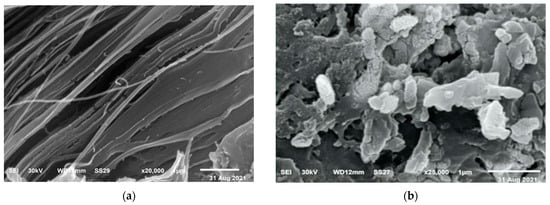
Figure 2.
Scanning electron microscopic (SEM) image of biosynthesis: nanocellulose (a) and Ag/cellulose nanocomposites (b) derived from U. lactuca.
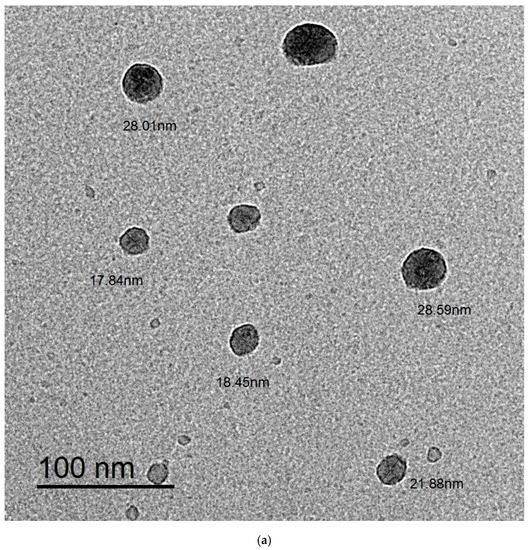
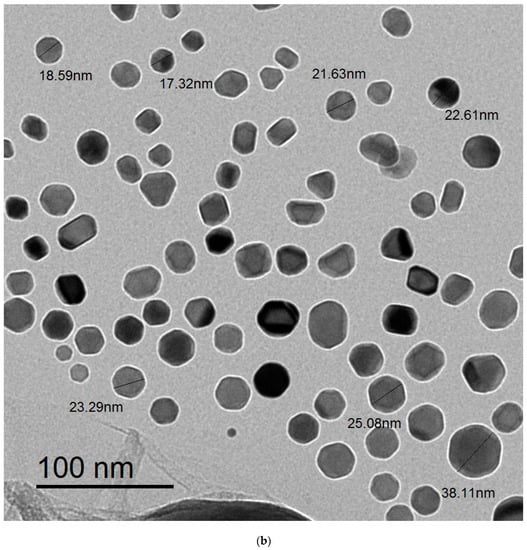
Figure 3.
Transmission electron microscopic (TEM) image of biosynthesis: Ulva/nanocellulose (a) and Ulva/Ag/cellulose nanocomposites (b).
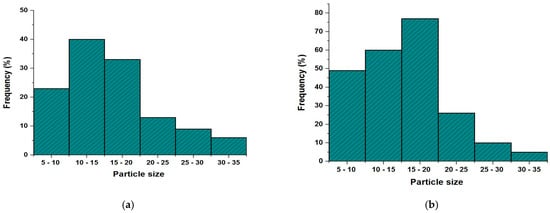
Figure 4.
Piratical size distribution of Ulva/nanocellulose (a) and Ulva/Ag/cellulose nanocomposites (b) derived from U. lactuca.
3.3. Energy-Dispersive X-ray Measurements
An analytical method called energy-dispersive X-ray spectroscopy can be used to determine the relative abundance of different elements in a given sample. It depends on a sample and an X-ray excitation source interacting (Figure 5). EDS can be used to identify the chemical elements present in a sample and quantify their relative abundance (qualitative and quantitative analysis). The EDS analysis of nanocellulose derived from U. lactuca confirmed that there are nine elements, C, O, Al, Si, Cl, Ca, Fe, Cu, and Sb, with percentage weights of 41.3, 4.1, 0.29, 0.73, 5.85, 6.08, 0.45, 0.87, and 2.17, respectively. Also, there are nine elements presented in Ag/cellulose nanocomposites, C, O, Na, Mg, Cl, Ca, Fe, Rb, and Ag, with percentage weights of 25.86, 40.41, 2.41, 0.57, 11.59, 8.68, 0.88, 1.26, and 8.34%, respectively. The weight of carbon atoms, 41.3% in nanocellulose, became 25.86% in Ag/cellulose nanocomposites, It appears that Ag replaced carbon atoms in Ulva/nanocellulose and formed Ag/cellulose nanocomposites (Figure 4a,b). The analysis of the TiO2/CNF composite using energy-dispersive X-ray spectroscopy (EDS) is mostly composed of the three elements, C, O, and Ti [68]. Energy-dispersive X-ray (EDX) analysis was used to emphasize the elemental structure of the silver nanospheres/graphene oxide composite [69]. Silver nanoparticles were well dispersed on the surface of cellulose and penetrated into the cellulose network [70].
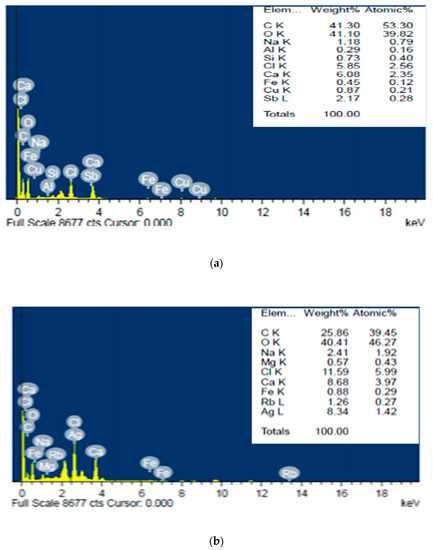
Figure 5.
Energy-dispersive X-ray spectrophotometry analysis of biosynthesis: nanocellulose (a) and Ulva/Ag/cellulose nanocomposites (b) derived from U. lactuca.
3.4. X-ray Diffraction
The intensity and shape of the peaks in the XRD patterns are affected by crystal size and crystalline shape. As can be seen, the XRD pattern of nanocellulose and Ulva/Ag/cellulose nanocomposites derived from U. lactuca indicate the crystal structure. The XRD diffraction patterns of nanocellulose derived from U. lactuca were recorded at 2θ, 10.8, 11.5, 15.1, 20.6, 21.9, 22.9, 25.4, 26.5, 27.9, 29, 31.6, 33.5, 34.6, 37.6, 40.4, 43.1, 45.5, 48.1, and 50.2, which correspond to lattice planes (hkl) (200), (210), (220), (400), (330), (331), (422), (431), (432), (440), (610), (443), (622), (551), (559), (733), (831), (911), and (762) (Figure 6a and Table 2). The major crystalline peak was obtained at 2θ (31.6°) with an intensity of 100% and crystalline size of 27.83, which confirmed that the nanocellulose obtained is nanocrystalline. The peaks at 2θ, 21.9, 22.9, and 45.5 are the broad bands and denote the amorphous nanocellulose. The conventional two-phase cellulose model illustrates cellulose chains as comprising both crystalline (ordered) and amorphous (less ordered) regions [71]. The methods of cellulose synthesis were affected in amorphous and crystalline regions in cellulose nanofibril (CNF) [22]. The XRD peaks of CNCs at 15°, 16.5°, 22.3°, and 34.4° reflect the (100), (110), (200), and (004) planes of cellulose [72]. The peaks of XRD diffraction patterns of Ulva/Ag/cellulose nanocomposites were recorded at 2θ, 20.6, 23.2, 27.7, 28.9, 29.5, 30.9, 31.6, 32.1, 36.2, 37.2, 43.3, 45.4, 47.5, 49.0, 54.6, 55.8, 56.4, 57.3, 58.2, 66.0, and 67.3. The main crystalline peak was obtained at 2θ (32.1°) with an intensity of 100% and crystalline size of 31.35, and all peaks were sharp and all crystalline sizes in nm, which confirmed the crystalline Ulva/Ag/cellulose nanocomposites (Figure 6b and Table 2b). When the diffraction peak is quite sharp, which indicates that the silver has good crystallization performance [73] The diffraction peaks at 38.1°, 44.19°, 64.4°, and 77.4° corresponding to lattice planes (hkl) from the (111), (200), (220), and (311) crystallographic planes of cubic AgNPs [74]. The XRD analysis of neat CNF-Ag NPs composites revealed the presence of Ag nanoparticles with the peaks at 2θ = 37.68°, 43.97°, 64.12° and 77.22° which are corresponding to (111), (200), (220), and (311) in the region from 20 to 80° [75].

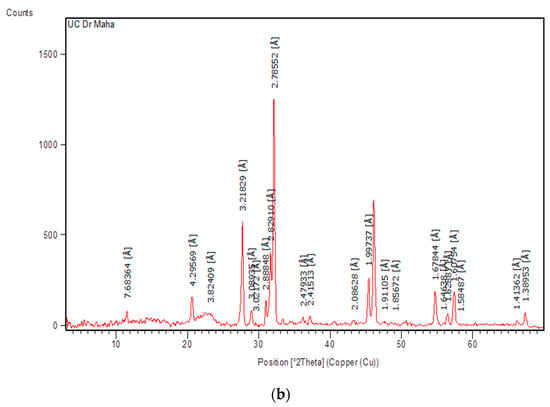
Figure 6.
XRD analysis of biosynthesis: nanocellulose (a) and Ulva/Ag/cellulose nanocomposites (b) derived from U. lactuca.

Table 2.
Simple peak indexing of Ulva/nanocellulose and Ulva/Ag/cellulose nanocomposites.) derived from U. lactuca.
3.5. Zeta Potential Analysis
From the zeta potential results presented in Figure 7a,b, it is noticeable that the surface charge of the nanocellulose derived from U. lactuca has a negative charge of −0.217 mV, and Ulva/Ag cellulose nanocomposite is−16.4 mV. The results demonstrate that Ulva/Ag cellulose nanocomposites are more negative than Ulva/nanocellulose. Abo-Elmagd et al. [76] stated that charges and strong resistive forces between the particles prevent aggregation and keep the nanoparticles in the medium stable. The zeta potential value of AgNPs photosynthesized by Oscillatoria limnetica was −27.4 [77]. The negative charge of nanoparticles revealed the repulsion among the nanoparticles and superior constancy. In agreement with this study, the Au/cellulose nanocomposite biofabricated by green alga Chlorella vulgaris is negative (−13.6 mV) [78]. The difference in zeta potential values of these results and other research may be due to the zeta potential of cellulose nanocrystal (CNC) aqueous dispersions, as was the function of solution conditions, including changing pH and different electrolyte identities and concentrations [79].
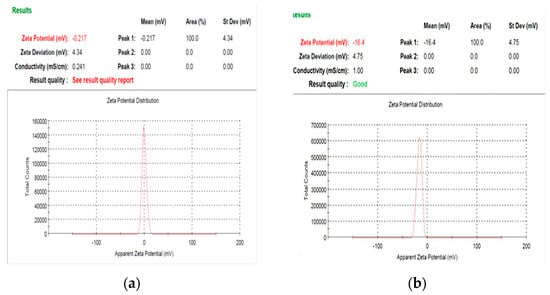
Figure 7.
Zeta potential analysis of biosynthesis: nanocellulose (a) and Ulva/Ag/cellulose nanocomposites (b) derived from U. lactuca.
3.6. Differential Scanning Calorimetry (DSC)
Figure 8 displays the DSC thermogram of Ulva/Ag/cellulose nanocomposites blended with fluoride, the temperature ranged from 20 °C to 600 °C. The glass transition temperature (Tg) 117.237 °C, was attained. The exothermic exhibited in the range of 148.648 and 169.788 °C may be due to the result of water evaporation. Composites exhibited initial decomposition around 100 °C, which could be due to the result of water evaporation [80]. According to the DSC curve, drug dehydration occurred between 50 and 121.8 °C [81]. In the second exothermic peak, ranging from 225 and 317.12 °C, thermal decomposition of cellulose nanocomposites was exhibited. The results are in agreement with Peter and Chrebet’s [82] reported cellulose decomposition beginning at temperatures of 250–260 °C. The results demonstrated the presence of exothermic peak during the heating scan of differential scanning calorimeter (DSC) analysis, called the cold crystallization peaks [83].
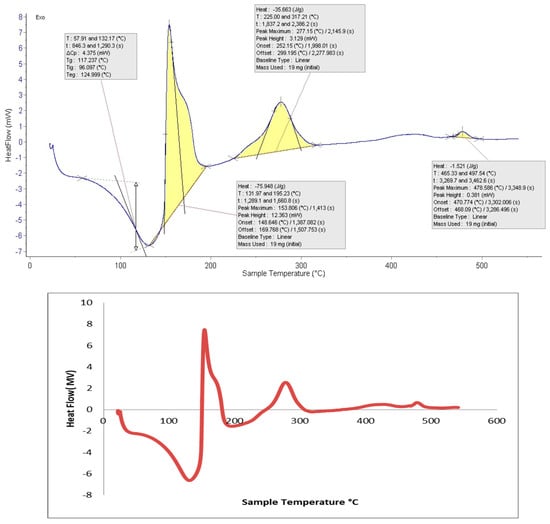
Figure 8.
DSC of Ulva/Ag/cellulose nanocomposite blend with fluoride.
3.7. Antimicrobial Activity
The agar-well diffusion technique was used to investigate the antibacterial activities of hybrids made of AgNPs, Ulva/nanocellulose, and Ulva/Ag/cellulose nanocomposite at different concentrations of nanocellulose (0.1, 0.2, 0.4, and 0.8 g) against both S. mutans ATCC 25175 and L. acidophilus CH-2.
Results obtained from the clear zone (mm) around the two bacterial types revealed that all examined nanoparticles have antibacterial activity on selected indicator organisms, however, Ulva/nanocellulose showed low antibacterial activity. Both AgNPs and Ulva/Ag/cellulose nanocomposite showed greater inhibitory zone diameter than that obtained by Ulva/nanocellulose. Furthermore, no significant differences in inhibition zone diameter were observed when different cellulose concentrations were applied to process Ulva/Ag/cellulose nanocomposites (Figure 9 and Table 3). The interaction and toxicity of nanoparticles are more significant with the bacterial surface due to their small size and high surface area. [23]. Results in Figure 8 and Table 3 demonstrate Ulva/nanocellulose possessed low antibacterial activities against both S. mutans ATCC 25175 and L. acidophilus CH-. Nanocellulose, by nature, does not have any antimicrobial properties and needs surface modification to make it an antimicrobial material [84]. Khulbe and Matsuura [85] recorded metal/metal oxide nanoparticles (such as Cu, Au, CuO, ZnO, Ag, TiO2, and MgO), silanes, chlorine, and chitosan as coupling agents that provide nanocellulose with antimicrobial properties. In a previous study, nanocellulose was modified by combining it with chitosan to inhibit the growth of Escherichia coli by 99% [86]. Oxide/cellulose nanocomposite presented afflicted antibacterial activity against Staphylococcus aureus and E. coli [27]. The AgNPs cellulose composite showed excellent antibacterial activity to prohibit bacterial infection and biofilm formation efficacy against most types of bacteria [87]. These nanoparticles have different mechanisms of action, including damaging the bacterial cell membrane by transference of Ag0 to Ag+, as well as the obstruction of the intercellular metabolic pathways following Ag+ penetration into the cell [88]. Antibacterial experimental results showed that the cellulose–silver hybrids showed excellent antimicrobial activities against E. coli (Gram-negative) and S. aureus (Gram-positive) [70]. Since they exhibit antibacterial properties, CNF/ZnO films can be utilized in biological applications [89]. The antibacterial activity of silver against K. pneumonia strains (Gram-negative bacteria) and S. aureus (Gram-positive bacteria) has been reported [90]. Silver ions change the function of the bacterial wall after binding with it [91]. El-Abd et al. [92] reported that coating biosynthesis AgNPs with acetic acid reduced the microflora in Ross broiler chicks such as Pseudomonas orizihabitain. Hamouda et al. [93] estimated that biosynthesis AgNPs using two red algae capping SDS possessed antibacterial activities against Micrococcus leutus, Kocuria varians, and Escherichia coli ATCC 8739. Silver nanoparticles biofabricated by Oscillatoria limnetica demonstrated the highest antibacterial activity against multidrug-resistant bacteria (MDR) [77].
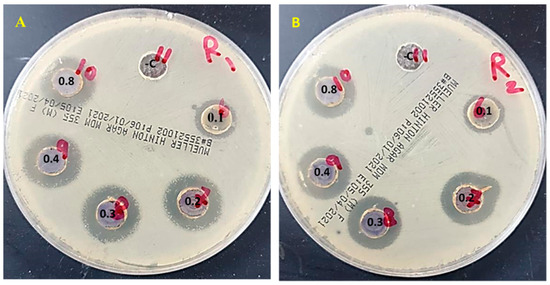
Figure 9.
Antimicrobial activity of control, Ulva/nanocellulose, and Ulva/Ag/cellulose nanocomposite at different concentrations of cellulose (0.1, 0.2, 0.4, and 0.8 g) against both (A) S. mutans ATCC 25175 (R1) and (B) L. acidophilus CH-2 (R2) Clear zones (11), control Ulva extract, (6) Ulva/nanocellulose, clear zone of different cellulose concentrations (0.1, 0.2, 0.4, and 0.8 g) of Ulva/Ag/cellulose nanocomposite (7, 8, 9, and 10), respectively.

Table 3.
Inhibition zone diameter (mm) of S. mutans ATCC 25175 and L. acidophilus CH-2 at different concentrations of cellulose percentage to form Ulva/Ag/cellulose nanocomposites, Ulva/AgNPs, and nanocellulose derived from U. lactuca.
3.8. Antimicrobial Activity of Nanocellulose Blended with Fluoride
The results presented in Table 4 show that fluoride had no inhibition zone present with two bacterial strains, while nanocellulose blended with fluoride was more effective than nanocellulose and Ulva/Ag/cellulose nanocomposites/fluoride in the case of S. mutans ATCC 25175. Ulva/Ag/cellulose nanocomposites/fluoride possessed more activity than nanocellulose/fluoride against L. acidophilus CH-2. Fluoridated polyethylene glycol-coated silver nanoparticles (PEG-AgNPs) can be used for antibacterial activity against S. mutans [94]. Silver nanoparticles blended with fluoride had antibacterial activity against Streptococcus mutans [95]. In comparison with sodium fluoride, silver nanofluoride was more effective in inhibiting pH lowering and adherence of S. mutans to the enamel surface [96]. Widakdo et al. [97] reported graphene oxide (GO) had antibacterial qualities against Escherichia coli, and the antibacterial level increased to 99.9% in almost all membranes with different pH values, due to the synergistic effect between AgNPs, GO, GO-AgpHx that showed a lower molecular transmission resistance and a higher antibacterial effect. Linear low-density polyethylene (LLDPE) combined with CaO and metal ion forms (LLDPE/CaO Ag, LLDPE/CaO Zn, and LLDPE/CaO Cu) were excellent and functioned as antibacterial agents against E. coli with an antibacterial rate of 99.9% [98].

Table 4.
Inhibition zone diameter (mm) of S. mutans ATCC 25175 and L. acidophilus CH-2 of Ulva/cellulose and Ulva/Ag/cellulose nanocomposites that were blended with fluoride. (Different letters denote significance value p < 0.05).
3.9. Minimum Inhibitory Concentration (MIC)
The MIC values of Ulva/Ag/cellulose nanocomposites were tested against S. mutans ATCC 25175 and L. acidophilus CH-2 at concentrations ranging from 0.0018 to 0.000056 g/mL. The inhibition zone diameter values (mm) were dose dependent and gradually decreased by decreasing the concentration of Ag/Ulva/cellulose nanocomposites (Table 5 and Figure 10). The results show that the MIC of both bacteria was 0.000112 g/mL (0.112 mg/L). Hamouda et al. [92] reported that the MIC of AgNPs synthesis by marine green alga Ulva fasciata is 0.5 mg/mL for S. aureus, 1.0 mg/mL for Salmonella enterica sub sp., 0.5 mg/mL for Aeromonas hydrophila, 2 mg/mL for E. coli O157, and 1.0 mg/mL for Bacillus cereus. There are many studies that have proved the antibacterial activities of AgNPs derived from biomaterials and Ag cellulose nanocomposites against different bacteria, as tabulated in Table 6.

Table 5.
Inhibition zone (mm) of S. mutans ATCC 25175 and L. acidophilus CH-2 at different concentrations of Ag/Ulva cellulose nanocomposites (g/mL) after 24 h.
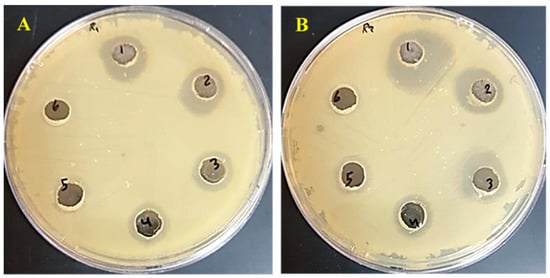
Figure 10.
Effect of different concentrations (mg/mL) of Ulva /Ag/cellulose nanocomposites on S. mutans (A) and L. acidophilus (B).

Table 6.
Comparison study with other researches on antibacterial activity.
4. Conclusions
Nanocomposites have led to hurriedly increasing applications in various fields. This study investigated the effect of nanocellulose and Ulva/Ag/cellulose nanocomposites derived from marine alga Ulva lactuca against S. mutans ATCC 25175 and L. acidophilus CH-2. Ulva/nanocellulose and Ulva/Ag/cellulose nanocomposites were characterized by TEM, SEM, zeta potential, EDX, XRD, and FT-IR. SEM confirmed that nanocellulose comprises filaments, and Ulva/Ag cellulose nanocomposites have fibrous surfaces. TEM images showed that the diameter of Ulva/nanocellulose ranged from 17 to 28 nm, while the diameter size of Ulva/Ag cellulose nanocomposites was 18.59 to 38.11. XRD confirmed that both Ulva/nanocellulose and Ulva/Ag cellulose nanocomposites were crystalline. Zeta potential indicated that Ulva/Ag cellulose nanocomposites were more negative in charge than Ulva/nanocellulose. Ulva/nanocellulose and Ulva/Ag cellulose nanocomposites have antibacterial activity against S. mutans and L. acidophilus. Data analysis revealed that Ulva/Ag/cellulose nanocomposites are more effective than Ulva/nanocellulose, and Ulva/Ag/cellulose nanocomposites blended with fluoride had more antibacterial activity than those not blended with fluoride. The antibacterial activities showed nonsignificant differences based on using different cellulose concentrations. Based on the data obtained, it is possible to deduce that Ulva/Ag/cellulose nanocomposites have the potential to be an economical and safe nanocomposite product from a natural source with antibacterial components that might be employed against bacteria that cause dental decay, blended to toothpaste, and add to tooth filler.
Author Contributions
R.A.H. conceptualization, data analysis, validation, supervision and writing. F.A.K.Q., methodology, and writing. F.S.S. and T.M.A.-S., investigation and resources. R.R.M., methodology, supervision. All authors have read and agreed to the published version of the manuscript.
Funding
This research received no external funding.
Institutional Review Board Statement
Not applicable.
Informed Consent Statement
Not applicable.
Data Availability Statement
The datasets spent and/or analyzed during this study are available from the corresponding author upon reasonable request.
Conflicts of Interest
The authors declare no conflict of interest.
References
- Uerlich, M.F.; Baker, S.R.; Day, P.F.; Brown, L.; Vettore, M.V. Common Determinants of Dental Caries and Obesity in Children: A Multi-Ethnic Nested Birth Cohort Study in the United Kingdom. Int. J. Environ. Res. Public Health 2021, 18, 12561. [Google Scholar] [CrossRef]
- Seymour, B.; James, Z.; Shroff Karhade, D.; Barrow, J.; Pruneddu, A.; Anderson, N.K.; Definition of Global Health, T.F.F.T. A definition of global oral health: An expert consensus approach by the Consortium of Universities for Global Health’s Global Oral Health Interest Group. Glob. Health Action 2020, 13, 1814001. [Google Scholar] [CrossRef]
- Veiga, N.; Pereira, C.; Amaral, O. Prevalence and determinants of dental caries in Portuguese children. Procedia-Soc. Behav. Sci. 2015, 171, 995–1002. [Google Scholar] [CrossRef]
- Selwitz, R.H.; Ismail, A.I.; Pitts, N.B. Dental caries. Lancet 2007, 369, 51–59. [Google Scholar] [CrossRef]
- Featherstone, J.D. Dental caries: A dynamic disease process. Aust. Dent. J. 2008, 53, 286–291. [Google Scholar] [CrossRef]
- Rostinawati, T.; Aryani, H.; Iskandar, Y. Identification of bacteria causing dental caries through genetic testing and activity assay of toothpastes. J. Pharm. Sci. Res. 2018, 10, 511–513. [Google Scholar]
- Mitchell, T.J. The pathogenesis of streptococcal infections: From tooth decay to meningitis. Nat. Rev. Microbiol. 2003, 1, 219–230. [Google Scholar] [CrossRef]
- Yadav, K.; Prakash, S. Dental caries: A microbiological approach. J. Clin. Infect. Dis. Pract. 2017, 2, 1–15. [Google Scholar] [CrossRef]
- Hohwy, J.; Reinholdt, J.; Kilian, M. Population dynamics of Streptococcus mitis in its natural habitat. Infect. Immun. 2001, 69, 6055–6063. [Google Scholar] [CrossRef]
- Kulshrestha, A.; Gupta, P. Polymicrobial interaction in biofilm: Mechanistic insights. Pathog. Dis. 2022, 80, ftac010. [Google Scholar] [CrossRef]
- Loesche, W.J. Microbiology of Dental Decay and Periodontal Disease. In Medical Microbiology, 4th ed.; University of Texas Medical Branch at Galveston: Galveston, TX, USA, 1996; Chapter 99. Available online: https://www.ncbi.nlm.nih.gov/books/NBK8259/ (accessed on 10 October 2022).
- Desselberger, U. Emerging and re-emerging infectious diseases. J. Infect. 2000, 40, 3–15. [Google Scholar] [CrossRef] [PubMed]
- Abiodun Solanke, I.M.F.; Ajayi, D.M.; Arigbede, A.O. Nanotechnology and its application in dentistry. Ann. Med. Health Sci. Res. 2014, 4, 171–177. [Google Scholar] [CrossRef] [PubMed]
- De Kwaadsteniet, M.I.C.H.E.L.E.; Botes, M.; Cloete, T.E. Application of nanotechnology in antimicrobial coatings in the water industry. Nano 2011, 6, 395–407. [Google Scholar] [CrossRef]
- Bhutiya, P.L.; Misra, N.; Rasheed, M.A.; Hasan, S.Z. Silver Nanoparticles Deposited Algal Nanofibrous Cellulose Sheet for Antibacterial Activity. BioNanoScience 2020, 10, 23–33. [Google Scholar] [CrossRef]
- Moon, R.J.; Martini, A.; Nairn, J.; Simonsen, J.; Youngblood, J. Cellulose nanomaterials review: Structure, properties and nanocomposites. Chem. Soc. Rev. 2011, 40, 3941–3994. [Google Scholar] [CrossRef] [PubMed]
- AI-Jawhari, I.F.H. Nanocellulose for Sustainable Future Applications. In Handbook of Nanomaterials and Nanocomposites for Energy and Environmental Applications; Springer: Berlin/Heidelberg, Germany, 2020; pp. 1–12. [Google Scholar] [CrossRef]
- Naz, S.; Ali, J.S.; Zia, M. Nanocellulose isolation characterization and applications: A journey from non-remedial to biomedical claims. Bio-Des. Manuf. 2019, 2, 187–212. [Google Scholar] [CrossRef]
- Saleh, M.H.S.D.E.; Muhamad, M.D.I.I.; Mamat, S.N.H. Cellulose Nanofiber Isolation and Its Fabrication into Bio-Polymer-A Review. In Proceedings of the International Conference on Agricultural and Food Engineering for Life (Cafei2012), Putrajaya, Malaysia, 26–28 November 2012; Volume 26, p. 28. [Google Scholar]
- Iwamoto, S.; Kai, W.; Isogai, A.; Iwata, T. Elastic modulus of single cellulose microfibrils from tunicate measured by atomic force microscopy. Biomacromolecules 2009, 10, 2571–2576. [Google Scholar] [CrossRef]
- Klemm, D.; Kramer, F.; Moritz, S.; Lindström, T.; Ankerfors, M.; Gray, D.; Dorris, A. Nanocelluloses: A new family of nature-based materials. Angew. Chem. Int. Ed. 2011, 50, 5438–5466. [Google Scholar] [CrossRef]
- Beck, S.; Bouchard, J.; Berry, R. Controlling the reflection wavelength of iridescent solid films of nanocrystalline cellulose. Biomacromolecules 2011, 12, 167–172. [Google Scholar] [CrossRef]
- Lee, K.Y.; Aitomäki, Y.; Berglund, L.A.; Oksman, K.; Bismarck, A. On the use of nanocellulose as reinforcement in polymer matrix composites. Compos. Sci. Technol. 2014, 105, 15–27. [Google Scholar] [CrossRef]
- Jorfi, M.; Foster, E.J. Recent advances in nanocellulose for biomedical applications. J. Appl. Polym. Sci. 2015, 132. [Google Scholar] [CrossRef]
- Liu, A.; Walther, A.; Ikkala, O.; Belova, L.; Berglund, L.A. Clay nanopaper with tough cellulose nanofiber matrix for fire retardancy and gas barrier functions. Biomacromolecules 2011, 12, 633–641. [Google Scholar] [CrossRef]
- Lefatshe, K.; Muiva, C.M.; Kebaabetswe, L.P. Extraction of nanocellulose and in-situ casting of ZnO/cellulose nanocomposite with enhanced photocatalytic and antibacterial activity. Carbohydr. Polym. 2017, 164, 301–308. [Google Scholar] [CrossRef]
- Janpetch, N.; Saito, N.; Rujiravanit, R. Fabrication of bacterial cellulose-ZnO composite via solution plasma process for antibacterial applications. Carbohydr. Polym. 2016, 148, 335–344. [Google Scholar] [CrossRef]
- Dong, Y.Y.; Liu, S.; Liu, Y.J.; Meng, L.Y.; Ma, M.G. Ag@ Fe3O4@ cellulose nanocrystals nanocomposites: Microwave-assisted hydrothermal synthesis, antimicrobial properties, and good adsorption of dye solution. J. Mater. Sci. 2017, 52, 8219–8230. [Google Scholar] [CrossRef]
- Xiong, R.; Lu, C.; Wang, Y.; Zhou, Z.; Zhang, X. Nanofibrillated cellulose as the support and reductant for the facile synthesis of Fe3O4/Ag nanocomposites with catalytic and antibacterial activity. J. Mater. Chem. A 2013, 1, 14910–14918. [Google Scholar] [CrossRef]
- Dong, Y.Y.; Deng, F.; Zhao, J.J.; He, J.; Ma, M.G.; Xu, F.; Sun, R.C. Environmentally friendly ultrosound synthesis and antibacterial activity of cellulose/Ag/AgCl hybrids. Carbohydr. Polym. 2014, 99, 166–172. [Google Scholar] [CrossRef]
- Leverett, D.H. Fluorides and the changing prevalence of dental caries. Science 1982, 217, 26–30. [Google Scholar] [CrossRef]
- Featherstone, J.D. Prevention and reversal of dental caries: Role of low level fluoride. Community Dent. Oral Epidemiol. 1999, 27, 31–40. [Google Scholar] [CrossRef]
- Whelton, H.P.; Spencer, A.J.; Do, L.G.; Rugg-Gunn, A.J. Fluoride revolution and dental caries: Evolution of policies for global use. J. Dent. Res. 2019, 98, 837–846. [Google Scholar] [CrossRef]
- Palmer, J.D. Dental health in children—An improving picture? Br. Dent. J. 1980, 149, 48–50. [Google Scholar] [CrossRef]
- Pitts, N.B.; Zero, D.T.; Marsh, P.D.; Ekstrand, K.; Weintraub, J.A.; Ramos-Gomez, F.; Ismail, A. Dental caries. Nat. Rev. Dis. Prim. 2017, 3, 17030. [Google Scholar] [CrossRef]
- Arends, J.; Christoffersen, J. Nature and role of loosely bound fluoride in dental caries. J. Dent. Res. 1990, 69 (Suppl. S2), 601–605. [Google Scholar] [CrossRef]
- Cury, J.A.; Tenuta, L.M.A.; Ribeiro, C.C.C.; Paes Leme, A.F. The importance of fluoride dentifrices to the current dental caries prevalence in Brazil. Braz. Dent. J. 2004, 15, 167–174. [Google Scholar] [CrossRef]
- Elgamily, H.; Safy, R.; Makharita, R. Influence of Medicinal Plant Extracts on the Growth of Oral Pathogens Streptococcus Mutans and Lactobacillus Acidophilus: An In-Vitro Study. Open Access. Maced. J. Med. Sci. 2019, 7, 2328. [Google Scholar] [CrossRef]
- Chen, X.; Zou, L.Q.; Niu, J.; Liu, W.; Peng, S.F.; Liu, C.M. The stability, sustained release and cellular antioxidant activity of curcumin nanoliposomes. Molecules 2015, 20, 14293–14311. [Google Scholar] [CrossRef]
- Greve, C.; Preketes, N.K.; Costard, R.; Koeppe, B.; Fidder, H.; Nibbering, E.T.J.; Temps, F.; Mukamel, S.; Elsaesser, T. N–H stretching modes of adenosine monomer in solution studied by ultrafast nonlinear infrared spectroscopy and ab initio calculations. J. Phys. Chem. A 2012, 116, 7636–7644. [Google Scholar] [CrossRef]
- Marchewka, M.K. Infrared and Raman spectra of bis (melaminium) sulfate dihydrate. J. Chem. Res. 2003, 8, 518–521. [Google Scholar] [CrossRef]
- Stone, N.; Kendall, C.; Smith, J.; Crow, P.; Barr, H. Raman spectroscopy for identification of epithelial cancers. Faraday Discuss. 2004, 126, 141–157. [Google Scholar] [CrossRef]
- Choo, L.P.; Mansfield, J.R.; Pizzi, N.; Somorjai, R.L.; Jackson, M.; Halliday, W.C.; Mantsch, H.H. Infrared spectra of human central nervous system tissue: Diagnosis of alzheimer’s disease by multivariate analyses. Biospectroscopy 1995, 1, 141–148. [Google Scholar] [CrossRef]
- Wang, Y.; Zhou, Q.; Li, B.; Liu, B.; Wu, G.; Ibrahim, M.; Xie, G.; Li, H.; Sun, G. Differentiation in MALDI-TOF MS and FTIR spectra between two closely related species Acidovorax oryzae and Acidovorax citrulli. BMC Microbiol. 2012, 12, 182. [Google Scholar] [CrossRef] [PubMed]
- Stenstad, P.; Andresen, M.; Tanem, B.S.; Stenius, P. Chemical surface modifications of microfibrillated cellulose. Cellulose 2008, 15, 35–45. [Google Scholar] [CrossRef]
- Pramono, E.; Utomo, S.B.; Wulandari, V.; Clegg, F. FTIR studies on the effect of concentration of polyethylene glycol on polimerization of Shellac. J. Phys. Conf. Ser. 2016, 776, 012053. [Google Scholar]
- Brown, M.D.; Hart, C.; Gazi, E.; Gardner, P.; Lockyer, N.; Clarke, N. Influence of omega-6 PUFA arachidonic acid and bone marrow adipocytes on metastatic spread from prostate cancer. Br. J. Cancer 2010, 102, 403–413. [Google Scholar] [CrossRef]
- Wang, X.; Qi, Z.; Wang, S.; Liu, G.; Gao, H.; Tian, Y. The study of a single BGC823 cell using Fourier transform infrared microspectroscopic imaging. Spectrochim. Acta Part A Mol. Biomol. Spectrosc. 2011, 79, 1660–1662. [Google Scholar] [CrossRef]
- Verdonck, M.; Denayer, A.; Delvaux, B.; Garaud, S.; De Wind, R.; Desmedt, C.; Sotiriou, C.; Willard-Gallo, K.; Goormaghtigh, E. Characterization of human breast cancer tissues by infrared imaging. Analyst 2016, 141, 606–619. [Google Scholar] [CrossRef]
- Pandey, A.; Jariwala, K.N. Detection of adulteration in ghee from markets of Ahmedabad by FT-IR spectroscopy. J. Chem. Pharm. Res. 2015, 7, 10–14. [Google Scholar]
- Junhom, C.; Weerapreeyakul, N.; Tanthanuch, W.; Thumanu, K. FTIR microspectroscopy defines early drug resistant human hepatocellular carcinoma (HepG2) cells. Exp. Cell Res. 2016, 340, 71–80. [Google Scholar] [CrossRef]
- Rahman, M.S.; Rana, M.; Spitzhorn, L.-S.; Akhtar, N.; Hasan, M.Z.; Choudhury, N.; Fehm, T.; Czernuszka, J.T.; Adjaye, J.; Asaduzzaman, S.M. Fabrication of biocompatible porous scaffolds based on hydroxyapatite/collagen/chitosan composite for restoration of defected maxillofacial mandible bone. Prog. Biomater. 2019, 8, 137–154. [Google Scholar] [CrossRef]
- Dreissig, I.; Machill, S.; Salzer, R.; Krafft, C. Quantification of brain lipids by FTIR spectroscopy and partial least squares regression. Spectrochim. Acta Part A Mol. Biomol. Spectrosc. 2009, 71, 2069–2075. [Google Scholar] [CrossRef]
- Naseer, K.; Ali, S.; Qazi, J. ATR-FTIR spectroscopy as the future of diagnostics: A systematic review of the approach using bio-fluids. Appl. Spectrosc. Rev. 2021, 56, 85–97. [Google Scholar] [CrossRef]
- Fung, M.F.K.; Senterman, M.K.; Mikhael, N.Z.; Lacelle, S.; Wong, P.T. Pressure-tuning fourier transform infrared spectroscopic study of carcinogenesis in human endometrium. Biospectroscopy 1996, 2, 155–165. [Google Scholar] [CrossRef]
- Balan, V.; Mihai, C.T.; Cojocaru, F.D.; Uritu, C.M.; Dodi, G.; Botezat, D.; Gardikiotis, I. Vibrational spectroscopy fingerprinting in medicine: From molecular to clinical practice. Materials 2019, 12, 2884. [Google Scholar] [CrossRef]
- Müller, G.; Schöpper, C.; Vos, H.; Kharazipour, A.; Polle, A. FTIR-ATR spectroscopic analyses of changes in wood properties during particle-and fibreboard production of hard-and softwood trees. BioResources 2009, 4, 49–71. [Google Scholar] [CrossRef]
- Asare, S. Synthesis, Characterization and Molecular Dynamic Simulations of Aqueous Choline Chloride Deep Eutectic Solvents; South Dakota State University: Brookings, SD, USA, 2018. [Google Scholar]
- Suzuki, T.; Sato, T.; Zhang, J.; Kanao, M.; Higuchi, M.; Maki, H. Electrochemically switchable photoluminescence of an anionic dye in a cationic metallo-supramolecular polymer. J. Mater. Chem. C 2016, 4, 1594–1598. [Google Scholar] [CrossRef]
- Trivedi, M.; Branton, A.; Trivedi, D.; Shettigar, H.; Bairwa, K.; Jana, S. Fourier transform infrared and ultraviolet-visible spectroscopic characterization of bio;field treated salicylic acid and sparfloxacin. Nat. Prod. Chem. Res. 2015, 5, 1–6. [Google Scholar] [CrossRef]
- Jamil, B.; Habib, H.; Abbasi, S.A.; Ihsan, A.; Nasir, H.; Imran, M. Development of cefotaxime impregnated chitosan as nano-antibiotics: De novo strategy to combat biofilm forming multi-drug resistant pathogens. Front. Microbiol. 2016, 7, 330. [Google Scholar] [CrossRef]
- Baisya, S.S. Coordination Chemistry of Pteridine Ligands with Transition and d10 Metals. Ph.D. Dissertation, University of North Bengal, West Bengal, India, 2016. [Google Scholar]
- Xiang, Z.; Gao, W.; Chen, L.; Lan, W.; Zhu, J.Y.; Runge, T. A comparison of cellulose nanofibrils produced from Cladophora glomerata algae and bleached eucalyptus pulp. Cellulose 2016, 23, 493–503. [Google Scholar] [CrossRef]
- Peng, N.; Huang, D.; Gong, C.; Wang, Y.; Zhou, J.; Chang, C. Controlled arrangement of nanocellulose in polymeric matrix: From reinforcement to functionality. ACS Nano 2020, 14, 16169–16179. [Google Scholar] [CrossRef]
- Tan, Z.; Chen, S.; Peng, X.; Zhang, L.; Gao, C. Polyamide membranes with nanoscale Turing structures for water purification. Science 2018, 360, 518–521. [Google Scholar] [CrossRef]
- Hamouda, R.A.; Hussein, M.H.; Elhadary, A.M.A.; Abuelmagd, M.A. Extruded polysaccharide/protein matrix from Arthrospira platensis cultures mediated silver nanoparticles biosynthesis and capping. Appl. Nanosci. 2020, 10, 3839–3855. [Google Scholar] [CrossRef]
- Rajeshkumar, S.; Tharani, M.; Rajeswari, V.D.; Alharbi, N.S.; Kadaikunnan, S.; Khaled, J.M.; Govindarajan, M. Synthesis of greener silver nanoparticle-based chitosan nanocomposites and their potential antimicrobial activity against oral pathogens. Green Process. Synth. 2021, 10, 658–665. [Google Scholar] [CrossRef]
- Liu, G.Q.; Pan, X.J.; Li, J.; Li, C.; Ji, C.L. Facile preparation and characterization of anatase TiO2/nanocellulose composite for photocatalytic degradation of methyl orange. J. Saudi Chem. Soc. 2021, 25, 101383. [Google Scholar] [CrossRef]
- Ullah, S.; Ahmad, A.; Subhan, F.; Jan, A.; Raza, M.; Khan, A.U.; Rahman, A.-U.; Khan, U.A.; Tariq, M.; Yuan, Q. Tobramycin mediated silver nanospheres/graphene oxide composite for synergistic therapy of bacterial infection. J. Photochem. Photobiol. B Biol. 2018, 183, 342–348. [Google Scholar] [CrossRef] [PubMed]
- Dong, Y.Y.; Fu, L.H.; Liu, S.; Ma, M.G.; Wang, B. Silver-reinforced cellulose hybrids with enhanced antibacterial activity: Synthesis, characterization, and mechanism. RSC Adv. 2015, 5, 97359–97366. [Google Scholar] [CrossRef]
- Sasi, S.; Krishna, C.A.; Sugunan, S.K.; Chandran, A.; Nair, P.R.; Subramanian, K.R.V.; Mathew, S. Low cost, high efficiency flexible supercapacitor electrodes made from areca nut husk nanocellulose and silver nanoparticle embedded polyaniline. RSC Adv. 2021, 11, 29564–29575. [Google Scholar] [CrossRef]
- Nisizawa, K. Mode of action of cellulases. J. Ferment. Technol. 1973, 51, 267–304. [Google Scholar]
- Fan, L.; Zhang, H.; Gao, M.; Zhang, M.; Liu, P.; Liu, X. Cellulose nanocrystals/silver nanoparticles: In-situ preparation and application in PVA films. Holzforschung 2020, 74, 523–528. [Google Scholar] [CrossRef]
- Bai, L.; Liu, Y.; Ding, A.; Ren, N.; Li, G.; Liang, H. Fabrication and characterization of thin-film composite (TFC) nanofiltration membranes incorporated with cellulose nanocrystals (CNCs) for enhanced desalination performance and dye removal. Chem. Eng. J. 2019, 358, 1519–1528. [Google Scholar] [CrossRef]
- Shin, J.U.; Gwon, J.; Lee, S.Y.; Yoo, H.S. Silver-incorporated nanocellulose fibers for antibacterial hydrogels. ACS Omega 2018, 3, 16150–16157. [Google Scholar] [CrossRef]
- Abo-Elmagd, R.A.; Hussein, M.H.; Hamouda, R.A.; Shalan, A.E.; Abdelrazak, A. Statistical optimization of photo-induced biofabrication of silver nanoparticles using the cell extract of Oscillatoria limnetica: Insight on characterization and antioxidant potentiality. RSC Adv. 2020, 10, 44232–44246. [Google Scholar] [CrossRef] [PubMed]
- Hamouda, R.A.; Hussein, M.H.; Abo-Elmagd, R.A.; Bawazir, S.S. Synthesis and biological characterization of silver nanoparticles derived from the cyanobacterium Oscillatoria limnetica. Sci. Rep. 2019, 9, 13071. [Google Scholar] [CrossRef] [PubMed]
- Hamouda, R.A.; El Maksoud, A.I.A.; Wageed, M.; Alotaibi, A.S.; Elebeedy, D.; Khalil, H.; Hassan, A.; Abdella, A. Characterization and anticancer activity of biosynthesized Au/cellulose nanocomposite from Chlorella vulgaris. Polymers 2021, 13, 3340. [Google Scholar] [CrossRef]
- Prathapan, R.; Thapa, R.; Garnier, G.; Tabor, R.F. Modulating the zeta potential of cellulose nanocrystals using salts and surfactants. Colloids Surf. A Physicochem. Eng. Asp. 2016, 509, 11–18. [Google Scholar] [CrossRef]
- Asad, M.; Saba, N.; Asiri, A.M.; Jawaid, M.; Indarti, E.; Wanrosli, W.D. Preparation and characterization of nanocomposite films from oil palm pulp nanocellulose/poly (Vinyl alcohol) by casting method. Carbohydr. Polym. 2018, 191, 103–111. [Google Scholar] [CrossRef]
- de Oliveira, A.R.; Molina, E.F.; de Castro Mesquita, P.; Fonseca, J.L.C.; Rossanezi, G.; de Freitas Fernandes-Pedrosa, M.; de Oliveira, A.G.; da Silva-Júnior, A.A. Structural and thermal properties of spray-dried methotrexate-loaded biodegradable microparticles. J. Therm. Anal. Calorim. 2013, 112, 555–565. [Google Scholar] [CrossRef]
- Rantuch, P.; Chrebet, T.O.M.Á.Š. Thermal decomposition of cellulose insulation. Cellul. Chem. Technol. 2014, 48, 461–467. [Google Scholar]
- Zhu, P.; Ma, D. Double cold crystallization peaks of poly (ethylene terephthalate)—1. Samples isothermally crystallized at low temperature. Eur. Polym. J. 1997, 33, 1817–1818. [Google Scholar] [CrossRef]
- Mou, K.; Li, J.; Wang, Y.; Cha, R.; Jiang, X. 2, 3-Dialdehyde nanofibrillated cellulose as a potential material for the treatment of MRSA infection. J. Mater. Chem. B 2017, 5, 7876–7884. [Google Scholar] [CrossRef]
- Khulbe, K.C.; Matsuura, T. Membrane applications. In Nanotechnology in Membrane Processes; Springer: Cham, Switzerland, 2021; pp. 199–343. [Google Scholar] [CrossRef]
- Tyagi, P.; Mathew, R.; Opperman, C.H.; Jameel, H.; Gonzalez, R.W.; Lucia, L.A.; Hubbe, M.A.; Pal, L. High-strength antibacterial chitosan–cellulose nanocrystal composite tissue paper. Langmuir 2018, 35, 104–112. [Google Scholar] [CrossRef] [PubMed]
- Nguyen, H.-L.; Jo, Y.K.; Cha, M.; Cha, Y.J.; Yoon, D.K.; Sanandiya, N.D.; Prajatelistia, E.; Oh, D.X.; Hwang, D.S. Mussel-inspired anisotropic nanocellulose and silver nanoparticle composite with improved mechanical properties, electrical conductivity and antibacterial activity. Polymers 2016, 8, 102. [Google Scholar] [CrossRef]
- Marambio-Jones, C.; Hoek, E. A review of the antibacterial effects of silver nanomaterials and potential implications for human health and the environment. J. Nanoparticle Res. 2010, 12, 1531–1551. [Google Scholar] [CrossRef]
- Farooq, A.; Patoary, M.K.; Zhang, M.; Mussana, H.; Li, M.; Naeem, M.A.; Mushtaq, M.; Farooq, A.; Liu, L. Cellulose from sources to nanocellulose and an overview of synthesis and properties of nanocellulose/zinc oxide nanocomposite materials. Int. J. Biol. Macromol. 2020, 154, 1050–1073. [Google Scholar] [CrossRef]
- Martins, N.C.T.; Freire, C.; Pinto, R.; Fernandes, S.C.M.; Neto, C.; Silvestre, A.; Causio, J.; Baldi, G.; Sadocco, P.; Trindade, T. Electrostatic assembly of Ag nanoparticles onto nanofibrillated cellulose for antibacterial paper products. Cellulose 2012, 19, 1425–1436. [Google Scholar] [CrossRef]
- Percival, S.L.; Bowler, P.G.; Russell, D. Bacterial resistance to silver in wound care. J. Hosp. Infect. 2005, 60, 1–7. [Google Scholar] [CrossRef]
- El-Abd, N.M.; Hamouda, R.A.; Al-Shaikh, T.M.; Abdel-Hamid, M.S. Influence of biosynthesized silver nanoparticles using red alga Corallina elongata on broiler chicks’ performance. Green Process. Synth. 2022, 11, 238–253. [Google Scholar] [CrossRef]
- Hamouda, R.A.; Abd El-Mongy, M.; Eid, K.F. Comparative study between two red algae for biosynthesis silver nanoparticles capping by SDS: Insights of characterization and antibacterial activity. Microb. Pathog. 2019, 129, 224–2321. [Google Scholar] [CrossRef]
- Yin, I.X.; Zhao, I.S.; Mei, M.L.; Lo, E.C.M.; Tangm, J.; Li, Q.; So, L.Y.; Chu, C.H. Synthesis and Characterization of Fluoridated Silver Nanoparticles and Their Potential as a Non-Staining Anti-Caries Agent. Int. J. Nanomed. 2020, 15, 3207–3215. [Google Scholar] [CrossRef]
- dos Santos, V.E.; Filho, A.V.; Ribeiro Targino, A.G.; Pelagio Flores, M.A.; Galembeck, A.; Caldas, A.F. A New “Silver-Bullet” to Treat Caries in Children—Nano Silver Fluoride: A Randomised Clinical Trial. J. Dent. 2014, 42, 945–951. [Google Scholar] [CrossRef]
- Vijayakumar, M.; Sabari Lavanya, S.J.; Ponnudurai Arangannal, J.J.; AarthiJ, A.S. Nano Silver Fluoride-Overview. Eur. J. Mol. Clin. Med. 2020, 7, 6573–6580. [Google Scholar]
- Widakdo, J.; Wu, P.W.; Austria, H.F.M.; Hung, W.S.; Yu, P.J.; Wang, C.F.; Hu, C.C.; Lee, K.R.; Lai, J.Y. Dual functional GO-Ag incorporated nanocomposite pervaporation membrane with alcohol dehydration performance and enhanced antibacterial property. Mater. Today Chem. 2022, 24, 100985. [Google Scholar] [CrossRef]
- Widakdo, J.; Chen, T.M.; Lin, M.C.; Wu, J.H.; Lin, T.L.; Yu, P.J.; Hung, W.S.; Lee, K.R. Evaluation of the Antibacterial Activity of Eco-Friendly Hybrid Composites on the Base of Oyster Shell Powder Modified by Metal Ions and LLDPE. Polymers 2022, 14, 3001. [Google Scholar] [CrossRef] [PubMed]
- Selvaraj, P.; Neethu, E.; Rathika, P.; Jayaseeli, J.P.R.; Jermy, B.R.; AbdulAzeez, S.; Dhas, T.S. Antibacterial potentials of methanolic extract and silver nanoparticles from marine algae. Biocatal. Agric. Biotechnol. 2020, 28, 101719. [Google Scholar] [CrossRef]
- Aboelfetoh, E.F.; El-Shenody, R.A.; Ghobara, M.M. Eco-friendly synthesis of silver nanoparticles using green algae (Caulerpa serrulata): Reaction optimization, catalytic and antibacterial activities. Environ. Monit. Assess. 2017, 189, 349. [Google Scholar] [CrossRef]
- Kathiraven, T.; Sundaramanickam, A.; Shanmugam, N.; Balasubramanian, T. Green synthesis of silver nanoparticles using marine algae Caulerpa racemosa and their antibacterial activity against some human pathogens. Appl. Nanosci. 2015, 5, 499–504. [Google Scholar] [CrossRef]
- Borah, D.; Das, N.; Das, N.; Bhattacharjee, A.; Sarmah, P.; Ghosh, K.; Bhattacharjee, C.R. Alga-mediated facile green synthesis of silver nanoparticles: Photophysical, catalytic and antibacterial activity. Appl. Organomet. Chem. 2020, 34, e5597. [Google Scholar] [CrossRef]
- Venkatesan, J.; Kim, S.K.; Shim, M.S. Antimicrobial, antioxidant, and anticancer activities of biosynthesized silver nanoparticles using marine algae Ecklonia cava. Nanomaterials 2016, 6, 235. [Google Scholar] [CrossRef]
- Garza-Cervantes, J.A.; Mendiola-Garza, G.; de Melo, E.M.; Dugmore, T.I.; Matharu, A.S.; Morones-Ramirez, J.R. Antimicrobial activity of a silver-microfibrillated cellulose biocomposite against susceptible and resistant bacteria. Sci. Rep. 2020, 10, 7281. [Google Scholar] [CrossRef]
- Thiagamani, S.M.K.; Rajini, N.; Siengchin, S.; Rajulu, A.V.; Hariram, N.; Ayrilmis, N. Influence of silver nanoparticles on the mechanical, thermal and antimicrobial properties of cellulose-based hybrid nanocomposites. Compos. Part B Eng. 2019, 165, 516–525. [Google Scholar] [CrossRef]
- Adepu, S.; Khandelwal, M. Broad-spectrum antimicrobial activity of bacterial cellulose silver nanocomposites with sustained release. J. Mater. Sci. 2018, 53, 1596–1609. [Google Scholar] [CrossRef]
- Audtarat, S.; Hongsachart, P.; Dasri, T.; Chio-Srichan, S.; Soontaranon, S.; Wongsinlatam, W.; Sompech, S. Green synthesis of silver nanoparticles loaded into bacterial cellulose for antimicrobial application. Nanocomposites 2022, 2018, 34–46. [Google Scholar] [CrossRef]
Disclaimer/Publisher’s Note: The statements, opinions and data contained in all publications are solely those of the individual author(s) and contributor(s) and not of MDPI and/or the editor(s). MDPI and/or the editor(s) disclaim responsibility for any injury to people or property resulting from any ideas, methods, instructions or products referred to in the content. |
© 2023 by the authors. Licensee MDPI, Basel, Switzerland. This article is an open access article distributed under the terms and conditions of the Creative Commons Attribution (CC BY) license (https://creativecommons.org/licenses/by/4.0/).